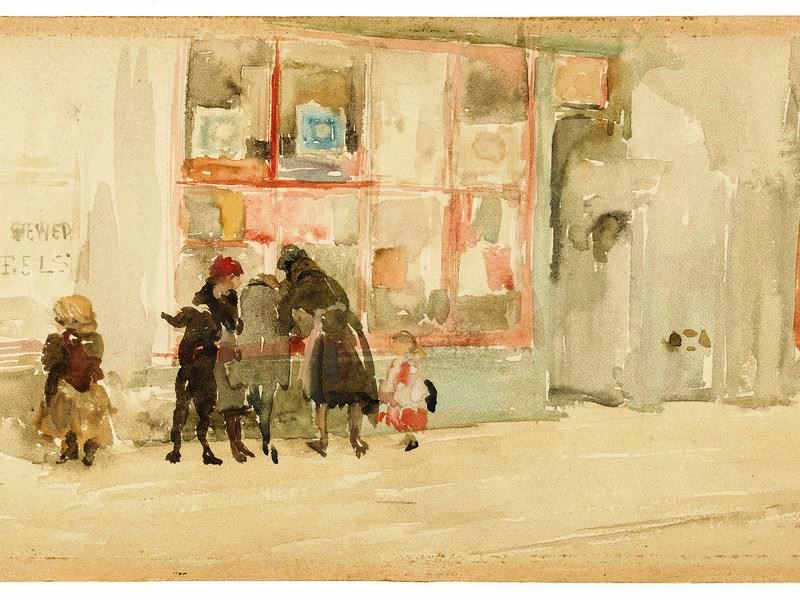Freer Gallery also revamps its popular Peacock Room, returning it to the way it looked a century ago

In 1923, when the Freer Gallery of Art became the first art museum to open on the National Mall in Washington, D.C, one room was devoted to the watercolors of the American artist James McNeill Whistler. The museum held one of the largest collections of such works in the world. The delicate works in gold wooden frames, despite being highly sensitive to light, were on view for about a decade before they were removed. But time had taken its toll on the works.
The artworks in the Freer collection cannot be loaned to other museums because of restrictions dictated by the founder’s will, so for more than 80 years, Whistler’s delicate watercolor gems were rarely seen. After much scholarship and conservation, the current exhibition, “Whistler in Watercolor,” brings the works once again to the public eye.
The delicacy and subtlety of the Whistler watercolors are in contrast to a bigger, splashier new Whistler exhibition at the Freer—“The Peacock Room in Blue and White,” in which the famous room-sized work is newly decorated as it was originally in the 1870s, with the blue and white Chinese ceramics of the original patron Frederick Leyland in London.
“The two exhibitions reflect the genuinely transformative friendship that took place between two men,” says the museum’s director Chase F. Robinson.
When Detroit industrialist Charles Lang Freer first met Whistler in his London home in 1890 to look into collecting more of his art, the painter had been including watercolors in his repertoire for a decade.
“This was a period in Whistler’s career when he urgently needed to reinvent himself, both financially and professionally,” says Lee Glazer, the Freer|Sackler’s former curator of American Art, who is now director of the Lunder Institute for American Art at Colby College.
This was not a good period for Whistler. In 1878, he had lost a libel suit against the art critic John Ruskin, a year after losing his patron Frederick Leyland over a financial dispute regarding the very Peacock Room now in the Freer. By 1879, Whistler had declared bankruptcy.
Born in Lowell, Massachusetts, Whistler studied in Paris and eventually moved to London. He learned watercolor technique as a boy and occasionally used it for preparatory studies early in his career, Glazer says. “But despite the tremendous popularity of watercolor in the British art world, and Whistler’s ultimate desire for success within that art world, he never seriously embraced watercolor until the 1880s.”
“Whistler rediscovered watercolor,” Glazer says, “during a sojourn in Venice between 1879 and 1880 and upon his return to London he created in his next step a prodigious number of these seemingly effortless works, depicting all manner of subjects.”
In his own writings, Whistler described his watercolors of figures, landscapes, interiors and nocturnes as “dainty,” “beautiful” and “portable.” He called them “delightful little things” and “amazing little beauties” but also “a wonderful game”—a scheme to bolster sales alongside similarly muted oil paintings and pastels in what Glazer calls “very carefully orchestrated solo exhibitions in both London and New York between 1884 and 1889.”
The watercolors, she says, “were intended to expand his market base to include what he described as rich Americans, shopping for art. But they were also, for the artist, a new way to demonstrate certain deeply held avant-garde aesthetic principals regarding finish, the value of artistic labor and verisimilitude.”
They were also a handy way to further his complicated and controversial ideas of art, conveying emotion through tone and color, through a more accessible medium.
Despite their big ambition, Glazer notes that the watercolors are “quite tiny. They’re itty bitty. None of them are bigger than a sheet of typing paper, and many of them are no bigger than an index card.”
But framed in the same kind of gold frame he used for his paintings and with no further matting to distinguish them as lesser than oils—he meant for them to have greater presence than mere sketches.
He tried variations of his nighttime “nocturnes” in watercolor, and lent his light touch to waterscapes such as The Ocean Wave and Blue and Silver-Chippy Channel.
There are landscapes, too, as the green-field dominated Green and Silver—Beaulieu, Touraine and the waterfront scenes of St. Ives: Cornwall and Southend Pier.
But his vivid portrait of Molly Finch is comparable to the oils he was commissioned to do. Further, reflected infrared images taken in the Freer’s lab shows how it had been reworked like an oil, reducing the width of the subject’s violet skirt.
And while there was some restoration as well as a study of the watercolors, some of their colors simply didn’t survive their long exhibition decades earlier. The only evidence of the “blazing yellow background” on Milly Finch described when it was first unveiled, was tucked in the edges hidden by the frame from light.
Light, of course, is also an issue in displaying The Peacock Room, whose shutters are flung open just once a month, on the third Thursday, to help preserve what Glazer calls “not only the most valuable piece of art in the Smithsonian collection, but also the most popular work of art in the Freer Gallery.”